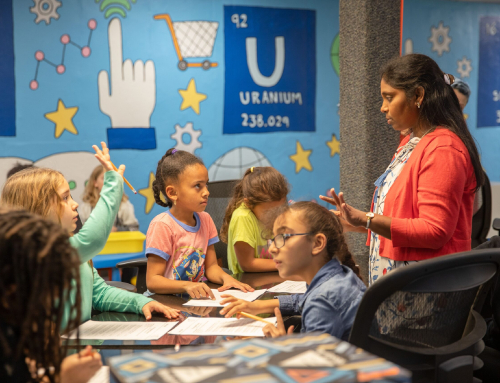
At ReadyAI we have witnessed that coupling AI education and project-based learning provides the right formula that is able to meet the challenges of preparing students in classrooms to solve the real world problems rather than traditional concept-based traditional classroom learning that often is displayed in the broader STEM education.
We think that authentic project-based learning focuses on developing critical thinking and problem-solving skills in the students. We have also witnessed at WAICY2018, this inquiry-based approach of learning to solve the problems given as projects to the students is a unique form of active learning. In a nutshell, project-based learning combines the essence of understanding and making. When students apply the concepts they learn in AI such as recognition, object manipulation, landmark-based navigation and many other aspects of AI, to solve authentic problems with the intention to produce results that really matter.
Inside and outside classrooms, we have seen repeatedly, a project that has been defined by students has scope of work, resources, and planning activity to execute and manage resources to get the preferred results. In today’s world where students are presented with an environment full of increasing complexity and ever-growing automation, project-based learning is preparing students to solve the real world problems.
At ReadyAI we believe there are many reasons why teachers and even parents should use project-based learning when it comes to AI education because it will be a front row seat on solving real-world problems.
It is all about the extent of work:
I believe one of the most important reasons behind project-based learning is that it enables educators, teachers, and students to learn and more important adopt formations around projects rather than having a concept and dull lecture-based learning about AI concepts or just coding and programming, which happens quite often in a traditional learning environment. With ReadyAI students actually, learn to understand AI concepts such as Visual Recognition, Landmark-based Navigation, Object Manipulation, Facial Recognition and Expressions, Speech Generation, Speech Recognition, State Machine Programming, put the execution into a structure under the guidance of their teachers.
Students need to learn to solve real-world problems with AI:
Project-based learning truly enables students to face real-world situation simulated in the forms of projects. We have seen this in a big way at WAICY2018. Students learn as they are doing what they know and develop new learning around hobbies, passions, and even future careers from invasive surgery to transporting and conserving energy. It could often help even develop new hobbies, passions and choosing for a new career path.
Students must improve interpersonal skills:
ReadyAI project-based approach considerably influences the development of interpersonal skills of the students. This approach of teaching and learning based on projects given often are more real and complex than in the assignments are in the traditional classroom environment. It gives the students need to organize and structure their energies in organizing their survey required for the projects, analyze the examination issues, and prepare reports to reach markets and collaboration. In this approach or different stages of the project, they improve their communication skills to collaborate with various stakeholders. This was most visible in WAICY2018.
AI Learning is not about coding, it is about Human Creativity
ReadyAI project-based learning develops a greater depth of understanding of AI concepts than in traditional classroom-based learning and outcomes in improved levels of student’s creativity. Real world situation given in the project are more able to bring students’ attention and grab their interest to bring about the needed level of thinking to apply new knowledge in a problem-solving context.
It is about genuine AI knowledge
ReadyAI learning ecosystem determines in-depth AI knowledge and experience of the students and sometimes of teachers in comparison to the fixed duration of the learning experience of traditional classroom-based learning. In project-based learning, students develop their skill and knowledge while classed-based learning has a shorter duration of memorizing based experience derived from a mechanical approach.
Real World Problem
Another great reason we have project-based learning is that projects are picked by the students or assigned by the teachers based on the students’ interest. Students are presented to have a choice based on their interest in selecting a real-world problem presented in the project. We really believe that interest-based selection of projects gives students unique methods of solving a variety of problems which are diversified even in the same class, whereas traditional classroom-based learning has question/answer essays and exam, including assignments given to all students of the class.
Unique Method of Assessment of Students’ Skills
This way allows the teachers to assess students capabilities to observe, survey and further explore, then designate the projects determining the activities and events based on their interest. Students find themselves able to sharpening their view and interpreting skills. Teachers directly assess the development of these skills among their students when they perform activities of the project work.
Visiting communities of Real World Problems.
A significant feature of project-based learning is filed-site visits by the students, teachers, and other involved as needed in the project implementation which opens new ways of learning and collaborating with stakeholders and new people.
Show of the capability
Teachers in our ReadyAI curriculum get greater opportunity to assess their students’ capabilities demonstrated in the performing activities and events organizing in the projects that the exams of the traditional classroom learning based on rote learning and memorizing to write what teacher have taught as their fixed and pre-determination of the topic or subject.
It is all about AI inclusion
Project-based learning is a powerful way of including AI concepts in the learning environment of the education system. Projects selected by students based on their interest are now likely to solve bigger problems.
Roadmap of Progress
In project-based learning teachers and students, can track and monitor their activities involved in the project given to the student to solve real-world problems. In traditional classroom-based learning this is missing, as not required or non-existing mechanism in the structure.
End-To-End Problem-Solving Experiences
In project-based learning students experience various stages of problem-solving through the structure of the project which includes various stages like project scoping, work planning, activity performing and tracking, managing uncertainties presented during problem-solving activities of the project, presentation of the project, and ending. Students have many chances to develop skills of observation, survey, research, reporting, presentation, communication, and cooperation/collaboration with people involved, team building, and leadership in the end-to-end problem-solving approach of project-based learning.
Working on a project to students is better nowadays, rather than making students sit in a class and speaking it all out for them. This makes the children go out on their own and learn on their own, giving them a better understanding of the topic. This way, students will learn to take up an initiative on their own and know more on their chosen topics. Obtaining AI knowledge should be fun and interesting, where children should engage themselves in a complex world of data, and at ReadyAI we want you to be part of it.




